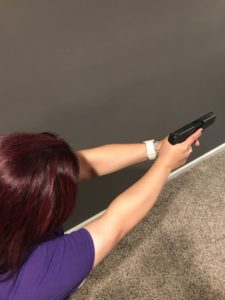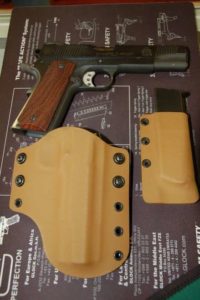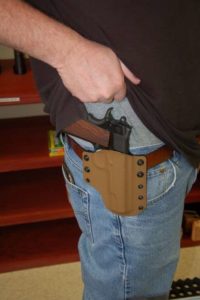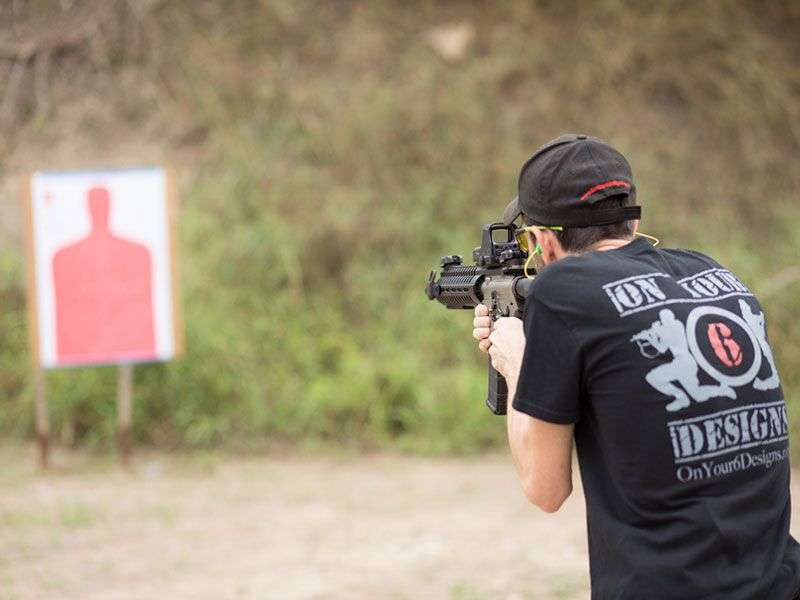Have you ever heard the saying “Fast is slow, slow is fast”? When taking training classes, I heard that a lot. It still comes up whenever we’re on the subject of target practice. And the more you go to the range to get your practice in, you’ll realize how important that reminder can be. Most people initially think you must go through the actions of shooting quickly in order to hit the target. It becomes a race against the clock to pull the trigger. But the truth is that if you have not had the chance to properly build the technique to build the muscle memory, it doesn’t matter how fast you react, you will most likely not hit the target. We are all busy with our day to day activities, so it’s hard to get in that practice daily at the range not to mention costly. Here are a few examples of things you can do at home to start building that technique.
Proper Handling of the Firearm

The first muscle memory you need to build is properly picking up and checking the firearm. Make sure your finger is completely away from the trigger so there is not an accidental discharge. You’ll want to make sure your finger is away from the trigger until you are ready to pull it. To prevent an accidental discharge, make sure to keep a high index finger. This is where your index finger settles above the trigger guard area along the side of the frame (just below the slide). Make sure you get a full and proper grip on the firearm to manage recoil. The webbing of your hand should be as high as possible on the tang (curved portion of the grip that’s closest to the slide). Here’s the link to a video that shows an example of the proper grip used for full support and safety. This exercise can be practiced by either drawing from a holster or picking up from a table. Once the firearm is in hand, get into the habit of checking your firearm. You should always know if it’s loaded or unloaded, chambered or not. Make sure the muzzle of the firearm is pointed in a safe direction and completely pull the slide back. This is to make sure you get a complete and unimpeded view of the chamber. For the purpose of your exercises you’ll need to do this to make sure the firearm is unloaded and not chambered.
Shooting Stance

Have you ever noticed when you get scared you instinctively curl your body inward? Let’s work with your body’s natural instinct to make yourself a smaller target when practicing the proper shooting stance. Your feet should be shoulder width apart with one foot slightly leading. Keep your feet straight, and toes pointed at your target. Slightly bend your knees and lean your torso forward with your shoulders rolled up to your ears. Counterbalance by slightly sticking out your seat. Extend your arms and lock your elbows. Initially, this stance may feel a little awkward, but this position helps keep your entire body square with the target.
Sight Alignment

Look around your home and pick a spot. It can be anything from a letter on a poster to an actual target. Get the practice aligning your sight to the target. You’re not pulling the trigger with these drills, you are simply building the technique in going through the action of picking up the firearm (and clearing it), getting in the stance and aligning with your target. This can be a drill you do when starting your day (again, you’ll want to make sure the firearm is unloaded and cleared). If you really want to step up the practice, grab an airsoft gun or a SIRT gun (if you have that kind of disposable income) to check the progress of your sight alignment. Set up a few targets around your home. Take aim every time the phone rings or in between commercials. Or, if you’re like my husband, you can use it as an excuse to hit up the range more often.
Trigger Manipulation

For this drill you will be pulling the trigger, so before you begin please double and triple check that the firearm is unloaded and not chambered. It’s best if you practice this away from all ammo for extra precaution. Practicing trigger manipulation reduces the chances of you anticipating the shot. When you anticipate the shot, you are more likely to flinch causing a dip in the alignment. You’ll need to know how much pressure you need to use to pull the trigger of your firearm. You can do this with either snap caps or you can dry fire (Note: Before you dry fire check the manufacturer specs to make sure this will not harm your firearm). One trick you can use is the coin trick. Lay a coin flat on the front sight and gently squeeze back the trigger. If the coin falls you will notice any errors immediately.
In Conclusion
I cannot stress enough how important it is to double and triple check to make sure your firearm is clear and unloaded prior to any of these exercises. These are only a few things you can practice to get yourself more familiar with your firearm. Build the muscle memory you may need if you ever find yourself in a life or death situation. These drills are only part of the equation you need to become a better shooter. It will take practice. If you can, take some training classes. Get the proper training as your foundation. Remember, practice doesn’t make perfect. Perfect practice makes perfect. Go through these drills slowly as you are becoming familiar with the movements. Pretty soon these movements will become fluid and will feel more natural.
Which of these drills is your favorite and why? Do you have any other drills you practice that I didn’t list here? Thanks for the feedback, have a great weekend and happy drilling!
We want to hear from our followers – Please comments below on your thoughts / Likes / Dislikes.
Source link: https://onyour6designs.com/building-muscle-memory/ by Nicholas Gangi at onyour6designs.com





